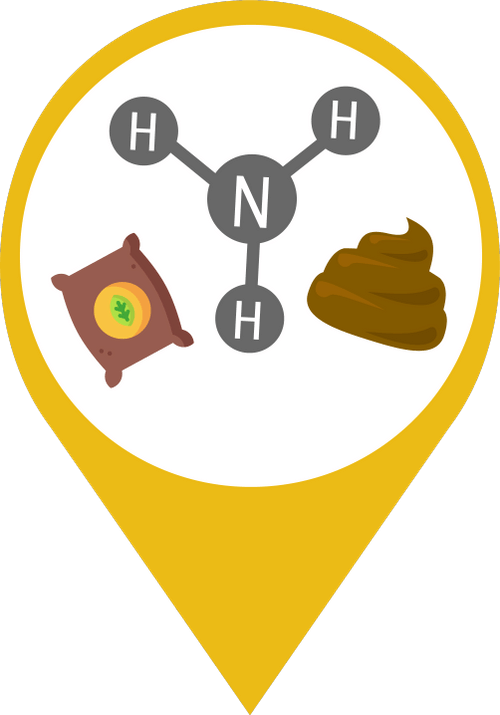Nutrients

Also known as nitrogen/nitrate/nitrite/ammonia, phosphorus/phosphate.
What is it?
“Nutrients” is a general term describing chemical elements and compounds (composed of several elements) that are essential to the growth and survival of living organisms. Nutrients are the core ingredient of fertilizers used in agriculture to help crops grow. Nutrients are an essential part of a healthy ecosystem, but too many nutrients can cause unwanted growth and may not be a good thing for an ecosystem.
In the context of surface water quality, the two most important nutrients are nitrogen (N) and phosphorus (P). Because these elements occur in inorganic and organic forms, they are often expressed as total nitrogen (TN) and total phosphorus (TP) to capture all the forms that affect plant growth. Although an excess amount of either of these key nutrients can have water quality implications, phosphorus usually receives more attention because it is typically a limiting factor for growth of aquatic plants and algae. Unnaturally large inputs of phosphorus typically initiate a series of processes that often lead to problematic water quality. To learn more about the effects of algal blooms on water quality and their relationship to phosphorus, read our fact page on algae.
Are nutrients in the water regulated in Alberta?
Some nutrients are regulated regarding their discharge into rivers and lakes in Alberta. Human activities, such as wastewater and sludge discharge into water, are often regulated. For example, The City of Calgary’s Total Loading Management Plan (TLMP) is a requirement of their wastewater approval from Alberta Environment and Parks’ (AEP) Environmental Protection and Enhancement Act (EPEA). The TLMP manages total loading of substances like total phosphorus as per their wastewater operating approval requirements by AEP. The Canadian federal government has Phosphorus Concentration Regulations that limit the amount of phosphorus in detergents, soaps and other cleaning products.
Canadian Drinking Water Guidelines have threshold limits for those nutrients that are dangerous in high concentrations.
The Environmental Quality Guidelines for Alberta Surface Waters has specific thresholds of several different nutrients, as does Alberta’s groundwater quality guidelines. These thresholds are designed to protect drinking water sources, aquatic life and livestock.
The Bow River Basin Phosphorus Management Plan is not a regulation, but it is a collaborative initiative among various basin stakeholders to reduce phosphorus inputs to the Bow River from non-point sources. This plan is a demonstration of the success that can be achieved through collaborative efforts to improve water quality.
Are nutrients in my water?
Source Water
There are some nutrients in source water and they help plants and animals to thrive. Natural sources of phosphorus, nitrogen, and other nutrients are rocks and soil, decomposing organic matter, and animal wastes.
Nutrients, including nitrate, are also found in groundwater and come from natural or human sources.
Nitrate, nitrite, ammonia and phosphate are common water testing metrics, so it is usually easy to find out which nutrients are present in a water source. Provincial government information and reports, or local lake management groups, can provide information.
Tap Water
Nutrients are present in tap water and are part of the standard water testing for drinking water. Where concentrations of nutrients are above acceptable thresholds, filters that use ion-exchange, reverse osmosis, or distillation technology can be used to remove some of the nutrients.
Nutrients are also present in well water because the groundwater pumped from wells naturally contains nutrients from weathering of rock. Human activity, such as fertilizer application, manure spreading, or improper maintenance of septic systems, may lead to additional nutrients entering groundwater.
What are the impacts on human health?
High concentrations of nitrate in drinking water can cause a rare but severe disease called methemoglobinemia, a potentially fatal disease in infants (also known as blue baby syndrome). If you are expecting a baby and you use well water, or are generally concerned about the level of nutrients or any constituents in your water, it is recommended to have your well water tested for nitrate and nitrite.
What are the impacts on the environment?
Because nutrients are essential for living things to grow, it is important that they are available in the environment. As they grow, aquatic plants and algae absorb nutrients. If nutrients are added to the aquatic ecosystem suddenly or in large quantities, the algae can grow very quickly and cause a bloom. Over-enrichment of any ecosystem with nutrients is called eutrophication, and in water bodies it can often lead to problematic water quality.
Algal blooms degrade water quality by decreasing dissolved oxygen. As aerobic microbes decompose dead plant material in the sediment, dissolved oxygen in the water is depleted. Oxygen depletion can cause fish kills and loss of other aquatic animal life. Algae also blocks light to aquatic plants, and sometimes releases compounds that smell or taste badly, or are even toxic.
How do nutrients get into the water?
Nutrients in water come from natural sources like plant and animal matter, and soil, as well as from human sources including manure, fertilizers, wastewater treatment plants, septic fields, and landfills.
What can we do about nutrients in the water?
Composting your food scraps instead of putting them in a garburator or the garbage ensures that more nutrients are returned to the soil instead of ending up downstream in the water.
Participate in municipal ‘green bin’ composting programs where available.
Follow instructions and quantities carefully when applying fertilizers on your property.
Generally, nutrient additions should be placed as close to the growing plant as possible without damaging the crop. The greater the distance between the plant and the fertilizer, the greater the chance that it will be lost before it can be taken up.
Ensure septic tanks and septic fields are working properly and not leaking.
Where can I find more information?
Is there Nitrate/nitrite in my Drinking Water?
Nutrient Management Planning
Bow River Phosphorus Management Plan
Alberta Lake Management Society
Sources:
http://www.agr.gc.ca/eng/science-and-innovation/agricultural-practices/soil-and-land/soil-nutrients/nutrient-management-planning/?id=1187355760327
Milk River Watershed Council Canada: Water Quality Monitoring http://www.mrwcc.ca/index.php/projects/water-quality-monitoring/
Water Quality – Regional Aquatics Monitoring Program (RAMP) http://www.ramp-alberta.org/RAMP.aspx
http://www.waterencyclopedia.com/Mi-Oc/Nutrients-in-Lakes-and-Streams.html
http://www1.agric.gov.ab.ca/$department/deptdocs.nsf/all/sag11864
https://www.ec.gc.ca/lcpe-cepa/eng/regulations/DetailReg.cfm?intReg=120
